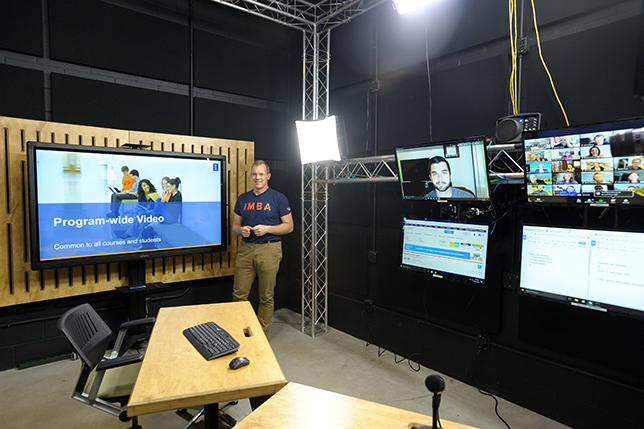How to Build a Production Studio for Online Courses
At the College of Business at the University of Illinois, video operations don't come in one size. Here's how the institution is handling studio setup for MOOCs, online courses, guest speakers and more.
- By Dian Schaffhauser
- 01/11/17

The University of Illinois Urbana-Champaign College of Business's video production studio (photo courtesy of UIUC)
When the University of Illinois Urbana-Champaign began running massive open online courses through Coursera, the institution quickly realized that the real power of those free courses was to introduce a world of prospective students to its campus programs — including the iMBA, its new online master's degree in business. The Digital Media team within the College of Business has played an important role in helping the college's production capabilities grow in quality and quantity. Now that team faces what may be its biggest challenge ever: accommodating up to 3,000 students in any particular online course.
Building up to that point has been an iterative process, said Digital Media Manager John Tubbs. The earliest video setup used for live sessions consisted of a webcam sitting on top of a 40-inch television monitor. "It was pretty crude," he recalled.
From there, Tubbs' operation grew into a fixed studio that could accommodate multiple camera views and presenters, green screen operations and teleprompting. He has found that well suited for specific kinds of productions, but not all. So the next iteration wasn't so much a studio as a mobile video outfit that could be set up to bring remote students to campus locations in innovative broadcast-caliber ways.
The college is in the process of finishing up two new studios to accommodate the latest production requirements, and their specs reflect all that Tubbs and his team have learned on the job, with a built-in assumption regarding explosive college growth.
The Primary Studio: 20x20 With Built-in Flexibility
The primary studio for the business school currently resides in a 400-square-foot space. The room incorporates a full-width green screen and a video monitor at stage right that allows instructors to see themselves interacting with words, charts, graphs or whatever else they're superimposed against.
Frequently, faculty like to work from a tablet, so the space also offers a podium that can be "rolled in for that situation," explained Tubbs. "They can have their digital stylus in hand, and we take a feed directly off that tablet and that goes into the recording as well." At the same time, a different camera angle is used for the tablet work to visually emphasize the shift from lecture to demonstration.
For Charlie Rose-like panel discussions or interviews, the same room can handle up to four people sitting and talking at a table. This setting is also used frequently for webinars geared toward recruitment.
Watching the Eyes
Because the room is fairly small, noted Tubbs, "we have to be very, very careful of our eye line" — the direction to which the instructor is reading and talking — "so they can keep their eyes going into the lens and they're not glancing over to a monitor that may be off to the side." In the case of the monitor's positioning on the stage-right wall used for a "weather person effect," Tubbs said, the eye line works because their body positioning is facing that monitor, which makes it "look correct to the student viewer."
Camera two — the center one — includes a monitor used as a teleprompter. Tubbs said that some faculty like to work from "full written-out word-for-word scripting" for their lectures. Others prefer bullet points, so they use the teleprompter screen for their presentation slides. The stage-right monitor can mirror that same content to allow presenters to see themselves "immersed."